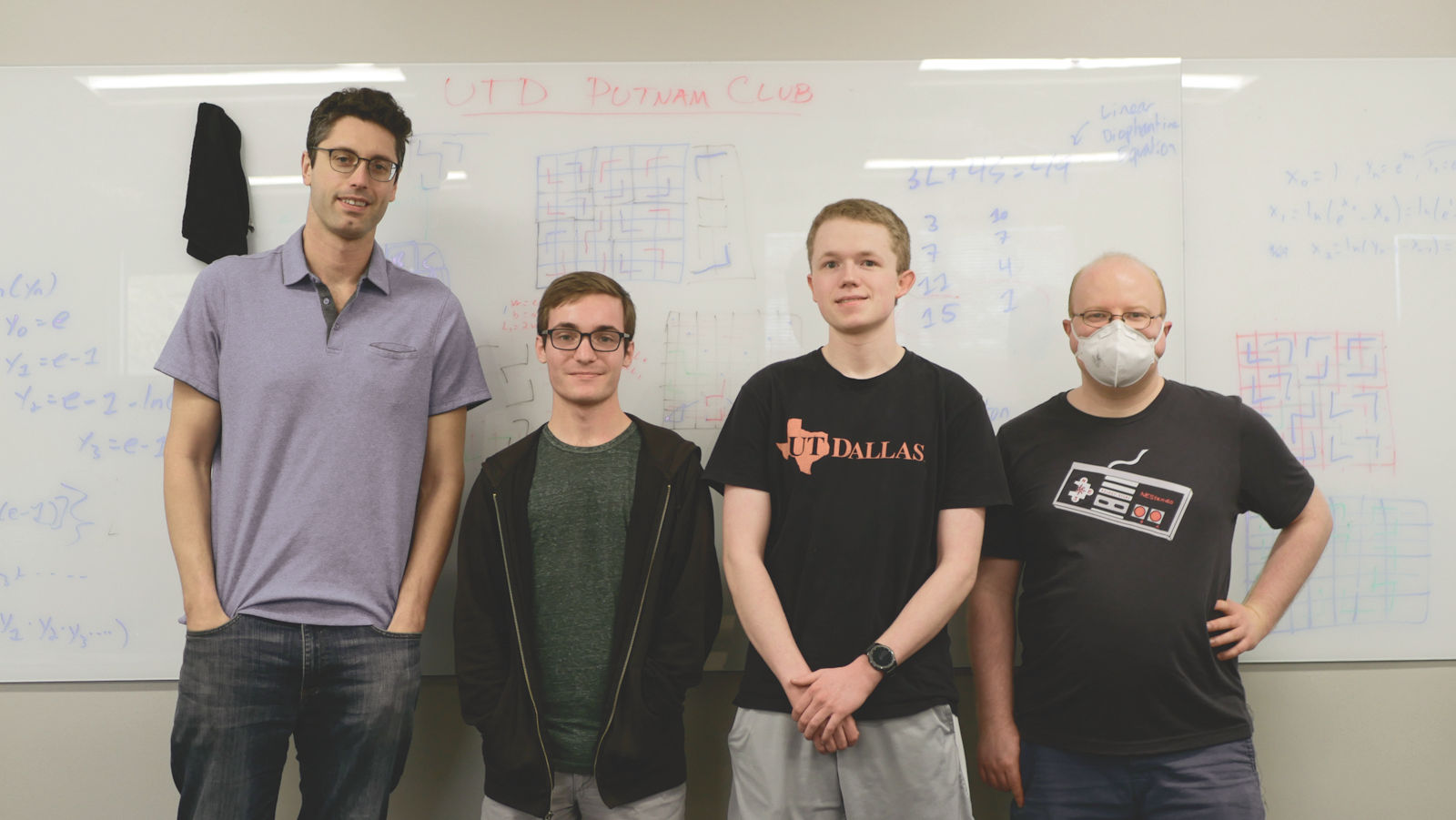UTD’s Putnam Team placed in the top 10 percentile of institutions at the most difficult undergraduate math competition in America on Dec. 3, the 83rd William Lowell Putnam Mathematical Competition.
The team consisted of math and computer science junior Evan Bailey, math junior Weston Miller and computer science sophomore Suraj Mathashery, who led UTD to place 32nd out of 456 competing institutions. Bailey placed 178th out of 3415 students while Miller and Mathashery scored in the top 500. The proof-based competition consisted of 12 questions — A1 through A6 and B1 through B6 — over the span of two three-hour sessions for a total of 120 points. The median score for all participants this year was only 1 out of 120.
At UTD, the competition was supervised by Assistant Professor in the Department of Mathematical Sciences Nathan Williams, who also runs the Putnam Club on campus along with graduate student and teaching assistant Matthew Babbitt.
“The Putnam is a yearly competition institutions all over the country participate [in],” Williams said. “It’s actually three hours in the morning and three hours in the afternoon on a Saturday, so students really have to love math if they want to do this. Just to give you an idea, it’s out of 120 and the median score this year was one, so half the people got a one or below.”
Students meet at the Putnam Club every Monday to solve math problems for practice. Additionally, two members from the Putnam team are currently working with Williams on independent projects.
“Weston Miller is doing an honors thesis with me,” Williams said. “With Evan, I could see that he was really interested in math and really strong. We’re currently working on a research problem actually in collaboration with another undergraduate at MIT.”
Bailey said he took Putnam for the first time his sophomore year when he added Mathematics as his second major and saw an advertisement for the competition. He scored 29 points at the 2021 Putnam competition and placed 212th out of 2975 participants, which placed him in the top 7.1% of all participants.
“It’s certainly a bit surreal, I suppose,” Bailey said. “The actual event is, you go and you sort of take this test for several hours in a row, and then you don’t hear back for several months while they do all the grading process. There’s, of course, a lot of anticipation during that period, so it does definitely feel nice when that sort of pays off, and it’s certainly motivating to try to perform better next year.”
Following his success at the competition in his sophomore year, Bailey said he decided to practice at the Putnam club in 2022. He is also involved in Code Burners at UTD, a programming competition club which helped with Putnam preparation. Bailey said that professors in both clubs have been helpful in his competitive math journey.
“Dr. Williams has definitely been a huge help in preparing for especially this year’s Putnam,” Bailey said. “Being able to talk to somebody very knowledgeable about the topics that come up on these exams … could be very helpful in future events. Dr. Chitturi from the computer science department sort of helps run the Code Burners club, which as I mentioned is a very significant part of my preparation for this event because the problems are so similar in how you approach them.”
Bailey has been interested in mathematics ever since his father would send math problems along with his lunch in elementary school, leading him to participate in UIL Math in high school. The similarities between computer science and math are what helped him prepare at the collegiate level. Bailey also said in the future, he is leaning toward pursuing a combination of CS and Math, specifically theoretical computer science and graph theory.
“On the Putnam, the problems tend to be a lot more specific,” Bailey said. “You’re given maybe one instance of the problem and you have to take advantage of certain properties of that instance, whereas in programming competitions you have to have a solution that works more generally. The level of detail you need in writing a proof versus writing a computer is also quite similar.”
While it is common to be nervous during competitions, Bailey said that he drowns out the nerves by being engrossed in the problem he’s solving. At this year’s competition, Bailey said that his favorite problem was A3.
“You’re given this process you perform on elements of a set of numbers which are the numbers up to some prime number p,and you have to determine how many different sequences of these numbers you can get,” Bailey said. “The problem itself didn’t end up being too challenging once you did some computation yourself, but the interesting part is, I learned afterwards, it ties into a certain area of math called cluster algebras, which has been fascinating to learn about.”

Bailey said participating in Putnam Club and Code Burners has both socially enriching and motivational in his collegiate journey. While the Putnam may be intimidating or challenging, Bailey said he recommends that interested students give it a try nonetheless.
“There’s not really too much of a downside even if you don’t have much time to prepare,” Bailey said. “Maybe you’ll discover you enjoy it and you could continue doing it into future years.”

Leave a Reply